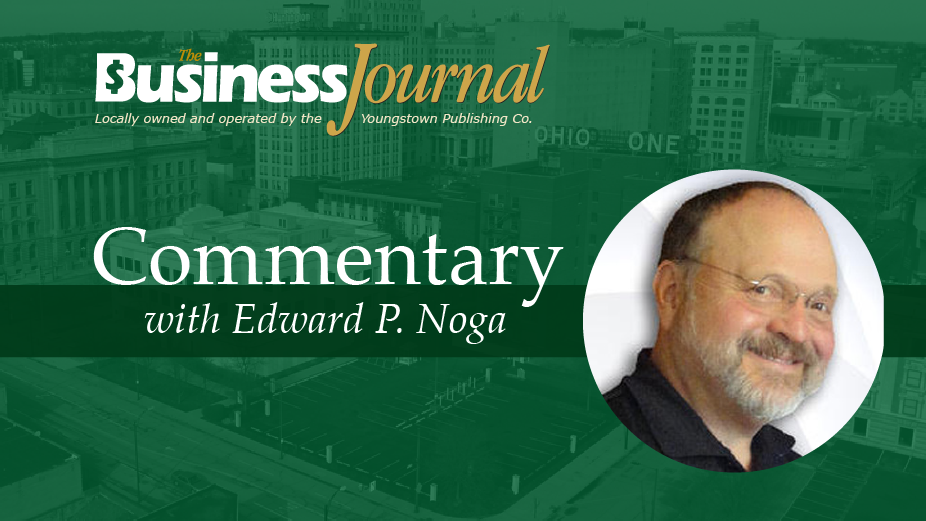By Edward P. Noga
YOUNGSTOWN, Ohio – Bishop David Bonnar is the new Roman Catholic bishop of the Youngstown Diocese. He was appointed last November and installed this past January.
He comes to us from Pittsburgh and has a wide scope of experience in many aspects of parish and diocesan life and ministry. In addition, he is proud to have been the Pittsburgh Steelers’ chaplain for several years.
(OK, you Browns fans. Don’t stop reading this column).
From his first visit to Youngstown and subsequent visits in preparing for his new ministry, there was an entourage of Pennsylvania folks who made their way across the border. Especially in the week leading up to his ordination/installation, many folks made the trip to his new home and place of work.
For many, it was probably their first time here. Making their way downtown, they encountered many projects in progress, including the cleaning of the exterior of Stambaugh Auditorium (built in 1926) and its renovation and the extensive restoration of the main library on Wick Avenue (built in 1911).
In addition, the ever-changing campus of Youngstown State University and the inner core of the downtown are sights to behold.
We have become accustomed to everyday traffic detours and construction sites everywhere we turn. It doesn’t take much for visitors (and us for whom the Mahoning Valley is home) to surmise what the story behind the story is for most of these projects. Visitors easily understand the need for a better flow of traffic, innovative pedestrian routes, the restoration of classic buildings, increased demand for downtown housing and the riverfront development.
Imagine folks coming and going for the first time to see where the new bishop, their friend, colleague and co-worker was going to work. How far do you think their jaws dropped when they witnessed the small, deteriorated, forlorn, weed- infested church on the western side of Elm Street between Wood Street and Rayen Avenue?
On a good day, the comment might go something like this: “What’s that?”
THAT is the Welsh Congregational church. For the story behind the story, here are a few things we know.
Early in the morning of April 12, 1861, Confederate soldiers fired upon Fort Sumter in the harbor of Charleston, S.C. Less than two days later, the Union forces inside the fort, surrendered. The Civil War began.
That same year, the Welsh Congregational Church opened. It is the oldest church in the city of Youngstown and one of the oldest houses of worship in the region.
Over the years, time, weather and changing demographics have taken their toll. Attempts were made to maintain and/or move the building. As I understand it, the current facade, including its steeple, is not part of the original structure. That’s understandable given the need for functionality over aesthetics in many cases back then. Some of the oldest pictures of our city (or any city) often show simple structures that were functional and easily maintained.
Back then, Youngstown and the surrounding area was still finding its niche as to how the city fit into a vast area called the Western Reserve. Remember, John Young, the pioneer founder of the city, died in 1825 when he was about 60 years old. When the Civil War broke out, the population of the city was about 6,000.
As the Mahoning Valley has struggled with the loss of jobs in past generations, in so many ways the focus has revolved around doing those things and generating the interest that will attract good jobs to the area and help to stem the tide of our young people leaving.
The Valley has many positive attributes and a population that often straddles the fence of energetic creativity and sobering, statistical data and demographics.
Part of our current place in the nation is recognition of what brought our families here and who has helped to shape where we’ve been. As we travel throughout our country, we have the opportunity to visit sites that have shaped the history of our United States. Restoration proposals and plans in communities are often sources of tremendous pride as we point to who we are.
I mentioned the extensive work being done to the city’s main library and wonderful concert hall for two reasons.
The first is to acknowledge the dreams of those who see the wisdom and greatness of preserving our past and reaching out to those who will support such projects with the will and desire to say proudly, “Let’s do this! What will it take?”
Second, I am grateful for those who have worked and still work to add the Welsh Congregational Church to the list of things we can point to with pride as we act. We have lost too many such structures.
The challenge of funding and finding a new home for this house of worship can seem daunting. There are enough dreamers out there, though, who can make it happen.
At a recent meeting with the priests of our six-county diocese, Bishop Bonnar said he wants to “tell the story” of our 78-year-old diocese by formally establishing and staffing an archival office. The story of our past can greatly enhance how we embrace the future.
